|
|
During the baroque era of violin making (which many people consider the violin's golden era) there was much experimentation taking place. In addition, many makers used their instruments as pallets for artistic expression. It was not uncommon for the head of the pegbox to be carved with a likeness of the owner's face, or with a lion's head. Many beautiful inlays were applied to the fingerboard, back, sides, and pegbox. Stradivari himself made some highly decorated instruments and experimented with different size bodies, as well as guitar-shaped bodies. Indeed, he also made guitars, bows, harps, and others. |
| Later, during the 1800's, the instrument became much more standardized. This has lead to the modern situation where there is no room for variation at all. In addition, craftspeople have become much more specialized, such that there are very few who make both instruments and bows, and most specialize further by focusing on only violins, or only violas, or only cellos. |
|
|
| |
|
|
I believe that modern craftspeople are even more skilled than the makers of 17th and 18th century Italy. However, I also believe that the specialization and eschewing of experimentation has hampered the craft's progress. If we reintroduce artistry and experimentation to the craft, I am sure the modern era will outshine all that have preceded us. This violin, inspired by works from the Art Nouveau era is my first effort to that end.
|
The instrument is constructed using traditional methods and materials. The top is spruce, and the back, sides, and head are of maple. Despite the appearance, the internal measurements of the body are very close to standard dimensions. The body is somewhat large, but the asymmetry makes the size feel normal to the player. The finish is a standard violin's oil varnish with metallic pigments added.
|
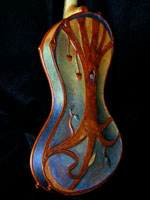 |
|
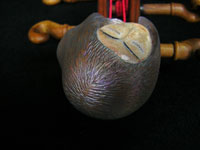 |
|
|
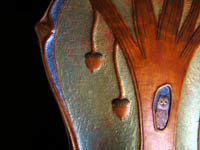 The decorations and designs on the instrument are all carved and then varnished as the rest of the instrument, but with varying colors. I kept the carvings on the top to a minimum so as to avoid adversely affecting the tone. The back of a violin has much less effect than the top on the tone, so I put many more carvings on it. The decorations and designs on the instrument are all carved and then varnished as the rest of the instrument, but with varying colors. I kept the carvings on the top to a minimum so as to avoid adversely affecting the tone. The back of a violin has much less effect than the top on the tone, so I put many more carvings on it. |
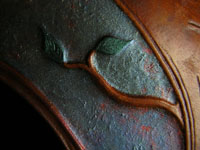 |
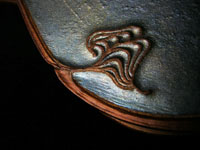 |
| |
The head of an instrument needs to be roughly the proper weight to maintain a fine sound, but this simple limitation allows one to carve almost anything. I used a female face simply because it is a common motif in art nouveau. The pegbox is open all the way through to the back, rather than leaving a floor as traditional. There is no real reason other than artistic style to leave a floor, and it is sometimes a bit easier to string the instrument with the pegbox open all the way through. It is also easier to carve this way.... |
|
|
|
| |
|
|
|
The fingerboard, tailpiece, pegs, end button, nut, and saddle are all carved of eastern hophornbeam. I have been interested in finding a temperate replacement for ebony, which is a rainforest wood. Hophornbeam is the hardest wood that grows here in New England, so I am using it experimentally. It is certainly fine for pegs and tailpiece. For the fingerboard it probably will not hold up as well as ebony, which is somewhat harder. Perhaps that is a small price to pay to protect the rainforest, and I do think it is attractive. |
| |
The purfling is usually an inlay (the double black line around the edge of the top and back). Its primary purpose is to prevent cracks on the edge of the top from progressing into the body of the top. Rather than standard wood inlay, I used a pigmented epoxy mixture to fill the usual mortice while giving the impression of copper. |
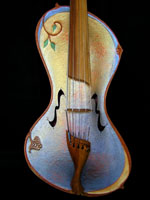 |
|
The sound holes are essential for the tone production of an instrument. They need not only to provide an opening for radiating sound, but they must also cut across the top to weaken it, thus allowing the bridge to get the top moving. The holes I designed for this instrument cut across exactly the same dimensions as traditional f holes would. |
| |
The varnish has presented some problems. To get the look I had in mind I had to mull in a very large quantity of pigment. This meant that the varnish really turned from varnish into paint, and that in turn means the finish is very flexible rather than brittle. While this looks nice it has a muting effect on the sound. |
|
|
|
|
To combat this deficiency, I made a bridge that does not have a waist like a traditional bridge does. This effectively transmits more high frequency sound from the strings to the belly and gives a little more punch to the sound. |
| |
I am still experimenting with ways to get the same look while maintaining the brittle nature of the varnish. In the meantime I have strung the violin with octave strings (one octave below normal). These sound great if played with amplification, and it sure is easier to carry around than a cello! For more information on octave strings, look on the questions page and also on the links page. Price $16,000. |
|
 |
|
